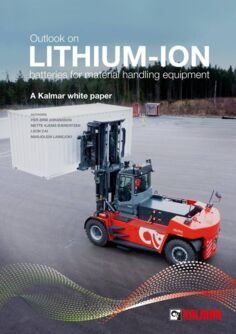- Branscher
-
Produkter & Service
- AC spare parts
- Begagnad utrustning
- CT drive upgrade
- EcoFlex Rental Solution
- Essential-serien
- Kalmar Modernisation Services
- Kalmar Parts Care
- Kalmar reservdelar
- Kalmar Service
- Kalmar starttjänster
- Kalmar Training Centre
- Kraninspektion
- Lifting ropes
- Motviktstruckar
- MyKalmar
- Reachstackers
- Reparation och renovering
- Terminal Design Service
- Terminaltraktorer
- Tomcontainerhantering
- Utrustningsuppgraderingar
- Automation & Robotics
- Miljö effektivt
- Nyheter
-
Kontakta oss
Outlook on lithium-ion batteries for material handling equipment
Understanding the benefits, general principles of use and challenges of lithium-ion batteries is crucial for companies seeking to reduce their carbon footprint and improve the sustainability of their operations.
Lithium-ion batteries are one of the core technologies used in today’s society. From the battery chemistries currently available, they offer an unmatched combination of size to power ratio, storage capacity and power output. In addition to being used in a vast range of consumer devices and electronic products, lithium-ion batteries are the most viable technology for powering electric vehicles on the market today, whether these are cars or heavy-duty equipment.
As the demand for zero-emission cargo handling solutions grows, solution providers and equipment operators will need to have a grasp of both the underlying technology as well as the global dynamics of how lithium-ion batteries are manufactured, used, re-used and recycled over the course of their lifetime.
In this white paper, we explore:
- Lithium-ion batteries’ technologies, expected development, challenges and safety
- The carbon footprint of lithium-ion batteries
- Current and upcoming legislation on lithium-ion batteries, regarding their carbon footprint, recyclability and transportation
- Future outlook of lithium-ion batteries supply, demand and costs.




Per-Erik Johansson, Technology Manager Electrification, Kalmar
Marjolein Lainejoki, Head of Sourcing Sustainability, Kalmar
Leon Cai, Battery System Engineer, Kalmar
Mette Kjems Bærentzen, Director of Decarbonisation, Kalmar
Kalmar Huvudkontor
Cargotec Sweden AB
Gatu adress: Kronborgsgränd 23, 164 46 Kista
Post adress: Box 1133, 164 22 Kista
Tel. +46 8 445 38 00
Kalmar är en del av Cargotec.
